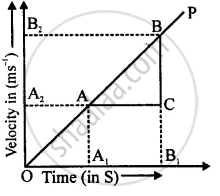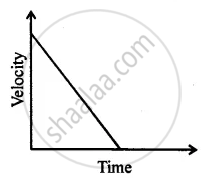Advertisements
Advertisements
Question
How can you find the following?
Acceleration from velocity – time graph.
Solution
Acceleration from velocity – time graph: Velocity – time graph for uniform motion in a straight line (OP) inclined to the time axis.

Take any two points A and B on this graph. From A and B draw perpendicular on the time axis as well as velocity axis in such a way that
OA1 = t1, OB1 = t2, OA2 = v1 and OB2 = v2
Slope of v – t graph = `"BC"/"AC"`
= `("v"_2-"v"_1)/("t"_2-"t"_1)=(Δ"v")/(Δ"t")` = Acceleration of the body
So, by knowing the slope of velocity – time graph for uniform motion, we can find the acceleration of the body.
APPEARS IN
RELATED QUESTIONS
Define velocity. What is the SI unit of velocity ?
A motorcycle moving with a speed of 5 m/s is subjected to an acceleration of 0.2 m/s2. Calculate the speed of the motorcycle after 10 seconds, and the distance travelled in this time.
A bus running at a speed of 18 km/h is stopped in 2.5 seconds by applying brakes. Calculate the retardation produced.
A cheetah starts from, rest, and accelerates at 2 m/s2 for 10 seconds. Calculate :
(a) the final velocity
(b) the distance travelled.
A bus was moving with a speed of 54 km/h. On applying brakes it stopped in 8 seconds. Calculate the acceleration.
A car is travelling along the road at 8 ms-1. It accelerates at 1 ms-2 for a distance of 18 m. How fast is it then travelling ?
A bus increases its speed from 36 km/h to 72 km/h in 10 seconds. Its acceleration is :
The velocity-time graph of a body in motion is a straight line inclined to the time axis. The correct statement is ___________
Multiple choice Question. Select the correct option.
A body dropped from the top of a tower reaches the ground in 4s. Height of the tower is
Can you suggest a real-life example about the motion of a body from the following velocity – time graph?

